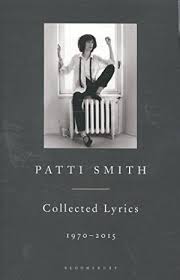Inspiring Older Readers
 posted on 21 Jan 2018
posted on 21 Jan 2018
Collected Lyrics 1970 – 2015 by Patti Smith
When Bob Dylan was awarded the Nobel prize for literature it kick-started a lively debate about whether song lyrics could really be thought of as poetry or as literature as some commentators insisted on calling it. I’m not sure many people changed their position as a result of that outburst of interest and I’m willing to bet that those who thought song lyrics are perfectly legitimate poetry and those who thought it wasn’t are pretty much occupying the same camps as before.
For what it’s worth I would like to draw a distinction between song writers who come to have their lyrics critiqued as poetry and poets who find their work can be put to music and changed or enhanced by that process. In that respect, Patti Smith is an interesting case and has been around for long enough now to have a foot in each camp.
This collection of her lyrics was a re-editing and pulling together of material across her career and was published to celebrate the 40th anniversary of the release of her seminal album, Horses. You really don’t have to be an aficionado of the 1970s New York arthouse club scene to immediately appreciate that Smith’s album was something very special and significantly different to a lot of other rock music that was around at the time. When I first heard it being played it wasn’t the music I heard but the extraordinary lyrics – sometimes screamed, sometimes growled, sometimes incantation but always extraordinary. These weren’t any ordinary pop or rock lyrics – this was poetry.
Soon after I got my hands on a copy of her sensational prose-poem, Piss Factory, released as a B-side to her first single, a cover of Hendrix’s Hey Joe. It was included on a Sire records compilation of punk released in the UK in 1977 and when I heard it I was just paralysed by how sensational it was. I played it over and over again listening to her astonishing half spoken, half intoned delivery over a raw, stripped, spikey piano accompaniment. It’s a stream of consciousness spilling from the head of a frustrated woman working shifts in a ‘piss factory inspecting pipe’. It’s the scream of anguish of a trapped animal, or maybe a trapped artist, who is determined this can’t be her fate as she is subjected to the brutal discipline of the factory managers and her fellow workers. But it’s also a scream of liberation that will be recognised by anyone who has felt themselves trapped in a job they can feel is killing their soul.
Forty hours thirty six dollars a week but it’s a paycheck, jack.
As she does her piecework in the boiling heat of the factory floor she imagines her escape – both physical and emotional. She knows that she is different to her nemesis, Dot Hook:
But you know she got nothin’ to hide and I got something to hide here called desire I got something to hide called desire. And I will get out of here….And I’m gonna go I’m gonna get out of here I’m gonna get on that train to New York city and I’m gonna be somebody…I’m gonna be a big star and I will never return never return no never return no never return to burn at this Piss Factory. And I will travel light Oh watch me now.
Simply glorious. Just typing that lyric out made me fall into its rhythms and gave my soul a boost.
And then there was the Horses album stuffed with daring reinterpretations of classic songs like Gloria or Land of a 1,000 Dances but also her own shamenesque compositions. Writing in 2015 in The Observer, Marc Randall commented that:
The historical importance of Horses is inarguable, above and beyond any particular aesthetic considerations. It introduced, fully formed, a daring new mystic voice in popular music. It referenced a classic persona, that of the androgynous poet/rocker, and gave it an exciting twist: the poet/rocker in question was a woman. And for listeners outside of New York, it was the first real full-length hint of the artistic ferment taking place in the mid-’70s at the juncture of Bowery and Bleecker.
And, of course, the image is impossible to ignore. The photograph used on the album cover was from a set crafted with the help of her best friend, photographer Robert Mapplethorpe, the black and white images of Smith subverting the classic male suit, white shirt and tie captured something quintessential about what would become the so-called ‘punk aesthetic’.
None of her early work in particular is easy listening and all of them are dominated for me by the lyrics – I have a particular fondness for the album Radio Ethiopia with its harrowing drug themes. Poppies in particular requires nerves of steel to listen to.
I think this collection illustrates that she got less angry as time went by but no less passionate. The sophistication of her lyrics deepened and she now holds a place in popular culture that is unchallenged in terms of the originality and importance of her contribution.
Unaccountably, the Bloomsbury first edition hardback of this book has been remaindered and you can pick it up for under £10. Why wouldn’t you?
Terry Potter
January 2018